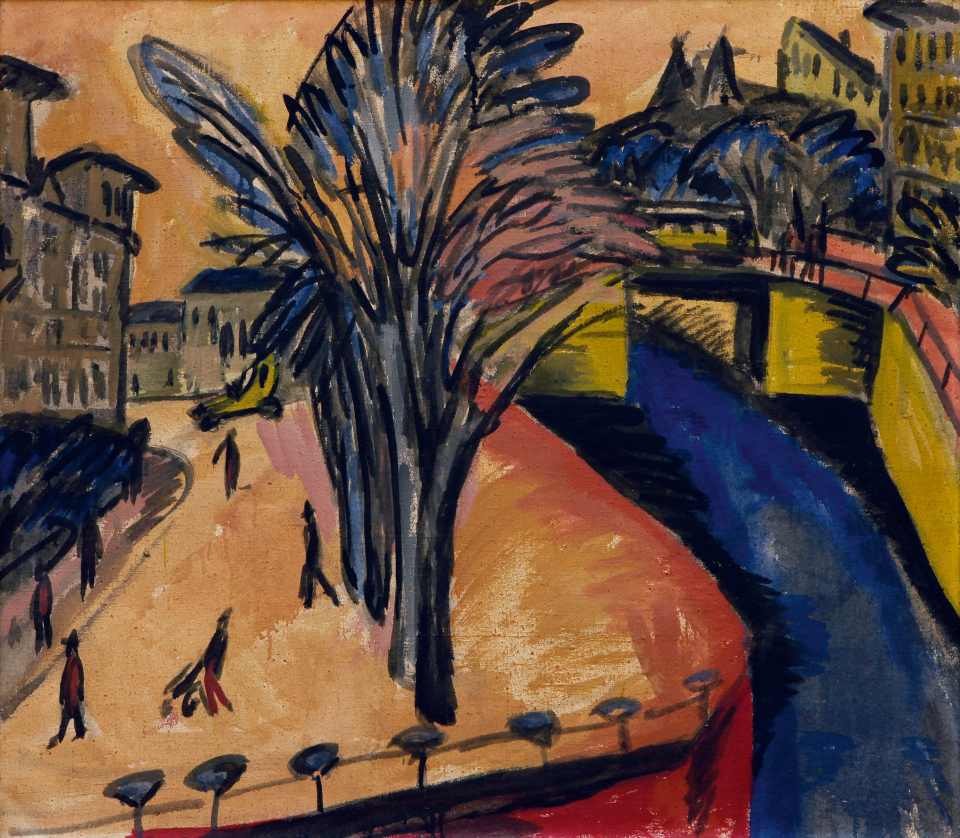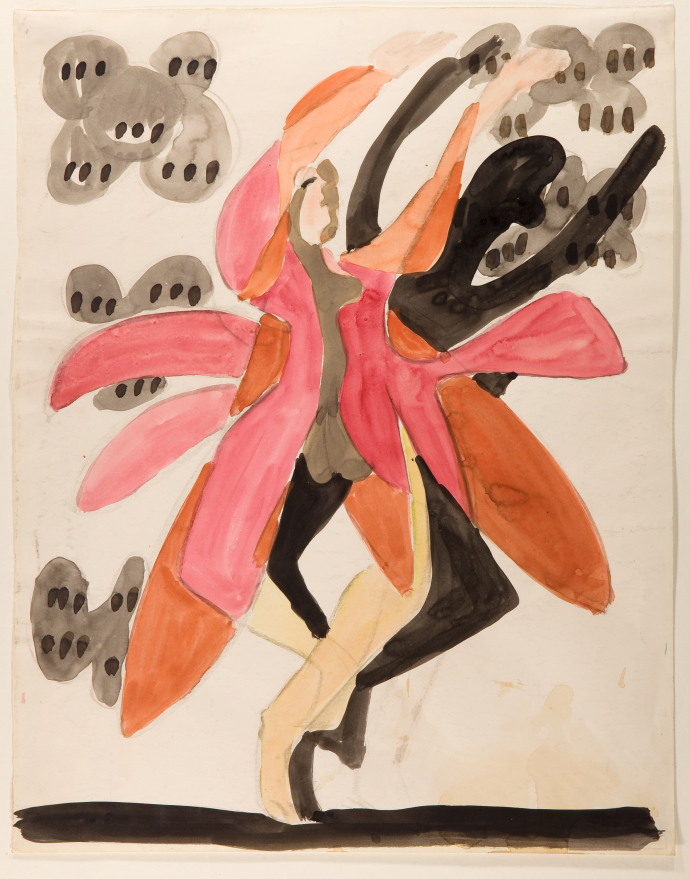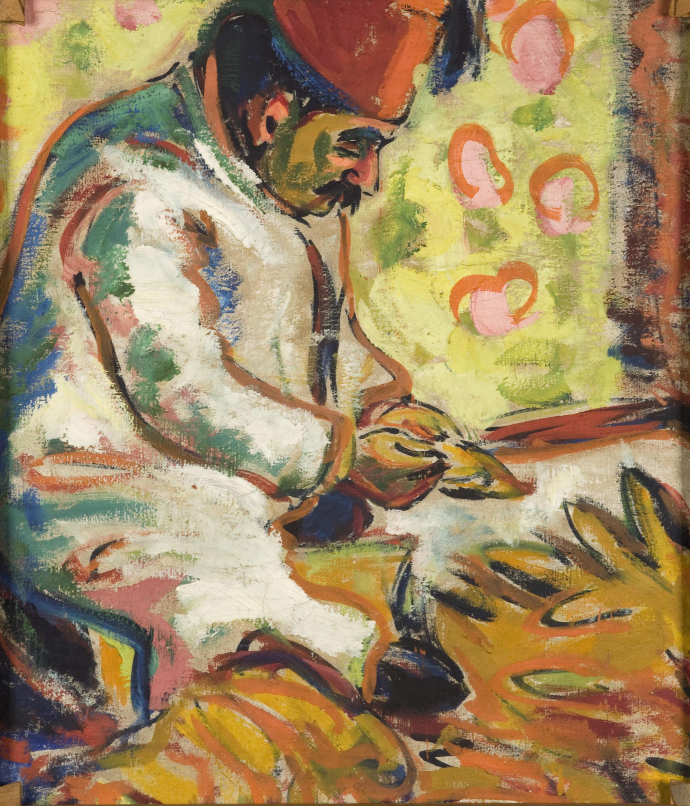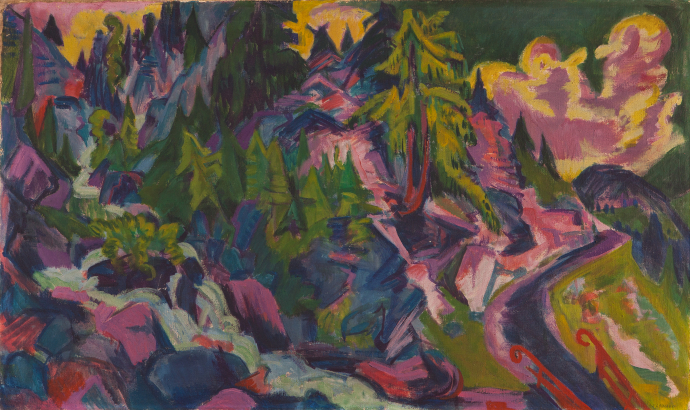Jugendstil-Bau > Ebene 1 > Galerie 14
Intro
In this painting, Ernst Ludwig Kirchner depicts the Engelufer riverbank in Berlin. From an elevated position, we look down on the Luisenstadt Canal, with the two towers of the Melanchthon Church (destroyed in World War II) visible in the background to the right.
In 1913 Kirchner had been living in Berlin for two years. Although he had already painted numerous cityscapes in his Dresden period, it was his Berlin metropolitan scenes that formed the culmination of his Expressionist work. The Brücke artist rarely depicted landmarks, being neither interested in a topographically precise rendition of Berlin nor in urban symbols.
With his concentration on the effect of color and contour, he simplifies the metropolis’s forms, completely liberating color from the object and presenting his subjective experience. Nervousness, abrasiveness, isolation, and urban anonymity are palpable—what is of interest here is not the spectacular but the tensions of everyday life. To this day, Kirchner’s Berlin street scenes, painted between 1913 and 1915, remain valid symbols of city life at the beginning of the 20th century.
Kunsthalle Mannheim
Transkription
Greenish-yellow canal walls, an orange-yellow esplanade, ochre houses, a yellowish sky: the color of the title dominates Ernst Ludwig Kirchner‘s painting „Yellow Engelufer, Berlin“. The blue-colored canal at the right side of the painting appears all the more vivid. On the esplanade which broadens out to become a square, trees like fans with muddy-blue contours form a staggered line towards the background. Chemnitz-born painter and printmaker Kirchner has them intersect with another line of trees with blue contours in the background, thus creating a vanishing point. The canal bank paths with their tomato-red and pale red tints also lead in that direction. Can you feel the pull created here?
The „dirty coloration“ is typical for the atmosphere of the city and street paintings Kirchner created between 1911 and 1915. The people? They are mere suggestions. Kirchner shows the metropolis as a „sea of stone“ – a term he, as co-founder of art movement „Die Brücke“, has coined for his expressionist city views. In these paintings, streets and buildings are executed as almost abstract structures which dominate the people. By his calligraphic use of black brushstrokes, he infuses his image with a state of excitement. That isvery characteristic for Expressionism, a style which turns towards the inner experience, and which expresses the abyss of the soul and nervous states of consciousness.
Quite different from this is the unfinished painting on the reverse side of the canvas: it shows an oriental man in a white robe with a red fez. Here, Kirchner moves very close to that person, creating an intimate atmosphere. This „Moroccan Man “, as the painting was titled in 2010, is sitting on a stool, immersed in his activity. Is he peeling or pitting a fruit? Kirchner has given the figure an orange contour, green, blue and pink traces delineate shadows and folds of the lightly colored robe. The background is a wall hanging with orange-lined, pink spots on a light, greenish-yellow base. The paint layer is very thin, the prime coat visible in places.
It is assumed that Kirchner painted the „Moroccan Man “ in Dresden, later rolled the canvas up and transported it to Berlin when he moved there in October 1911. „Yellow Engelufer, Berlin“ was then painted on the reverse side of the Moroccan Man.
This habit of painting both sides of the canvas was one of Kirchner’s quirks. He reasoned in 1917 that it was due to his financial difficulties: "I, too, have to make economies now, and all material has become very expensive. I thank God that every canvas has two sides to paint on."




![Taunuslandschaft Beschriftung verso: in Bleistift o.li.: "3 [eingekreist]": Signatur: in Bleistift unter dem Druckstock re.: "E L Kirchner": Beschriftung recto: in Bleistift unter dem Druckstock li.: "Eigendruck"; u.li.: "[unleserlich]"; u.mi.: "[unleserlich]"; "Taunusls"; u.re: "R 18263"](/sites/default/files/styles/700_breit/public/digitalisate/G1058_MOS_2018.jpg?itok=rYSjLsj4)
![Das elegante Paar Signatur: in Bleistrift u.mi.: "E L Kirchner 12.": Beschriftung verso: [nicht einsehbar]; in Bleistift auf Trägerpapier "170." [umkreist]: Beschriftung recto: ohne](/sites/default/files/styles/700_breit/public/digitalisate/G4672_MOS_2017.jpg?itok=xroigcxg)
